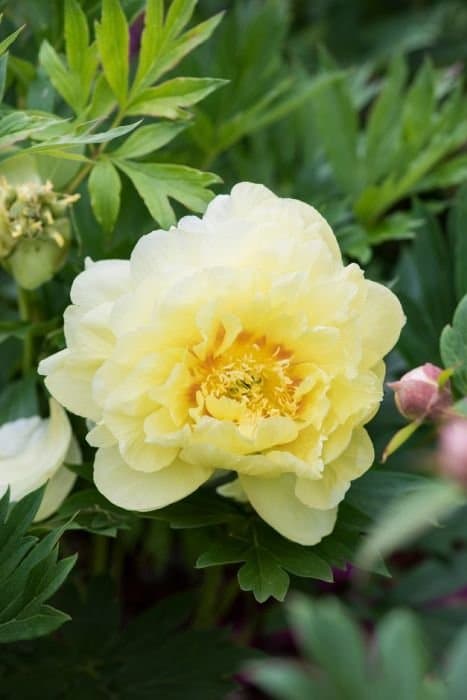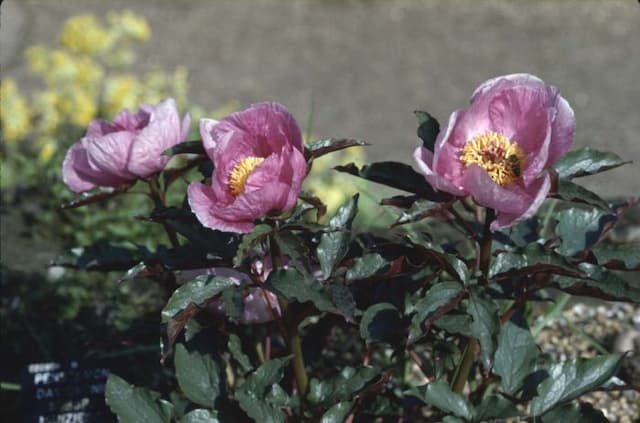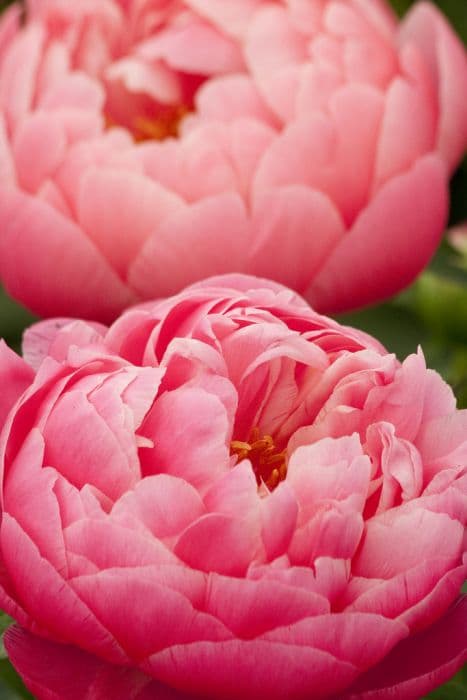Peony Paeonia × festiva 'Rubra Plena' (d)

ABOUT
The plant commonly known as Double Red Peony showcases a luxurious display of deep, crimson red flowers that are fully double, giving them a very full, rounded and fluffy appearance. Each petal is soft to the touch and contributes to the densely packed, large blooms. These flowers emit a delightful fragrance that is a treat for the senses and often attracts bees, butterflies, and other pollinators to the garden. The foliage is a lush green, presenting a striking contrast against the vibrant red of the blossoms, and consists of compound leaves that are elegantly divided into leaflets with a somewhat glossy finish. The plant has a bushy habit, producing a number of these spectacular blooms each spring or early summer, creating a focal point in any garden space where they are planted.
About this plant
 Names
NamesFamily
Paeoniaceae.
Synonyms
Red Charm Peony, Double Red Peony, Festiva Maxima Peony, Festive Peony
Common names
Paeonia × festiva 'Rubra Plena'.
 Toxicity
ToxicityTo humans
Peonies, including the variety Paeonia × festiva 'Rubra Plena', are generally considered non-toxic to humans. There is limited information on severe toxicity or poisoning from ingesting peonies for humans; however, ingestion of plant parts is not recommended as they could potentially cause gastrointestinal upset or discomfort.
To pets
Peonies, including the variety Paeonia × festiva 'Rubra Plena', are considered to be mildly toxic to pets if ingested. The symptoms of peony poisoning in pets can include vomiting, diarrhea, and drooling. While they are not typically life-threatening, it is advised to prevent pets from ingesting the plant to avoid these possible negative health consequences.
 Characteristics
CharacteristicsLife cycle
Perennials
Foliage type
Deciduous
Color of leaves
Green
Flower color
Red
Height
2-3 feet (60-90 cm)
Spread
2-3 feet (60-90 cm)
Plant type
Herb
Hardiness zones
3-8
Native area
Asia
Benefits
 General Benefits
General Benefits- Aesthetic Appeal: Paeonia, commonly known as Peony, has large, showy blooms that provide visual interest to any garden or landscape.
- Variety: Peonies come in a wide range of colors and forms, adding diversity to garden designs.
- Longevity: Peonies are known for their longevity, often living for decades and can be a permanent fixture in gardens.
- Seasonal Interest: Peonies bloom in late spring to early summer, filling a bloom gap after early spring bulbs and before summer flowers.
- Low Maintenance: Once established, peonies require minimal maintenance, making them a convenient choice for gardeners of all skill levels.
- Attract Pollinators: The flowers attract bees, which are essential for pollinating many other plants in the garden.
- Cut Flowers: Peony flowers are popular in floral arrangements and can bring beauty indoors with their luxurious blooms.
- Hardiness: Peonies are hardy plants that can resist frost and tolerate cold winters, making them suitable for a variety of climates.
- Heritage Value: Some peony varieties are heirloom plants that have been cherished for generations, offering historical significance.
 Medical Properties
Medical Properties- Anti-inflammatory: Peony (Paeonia) extracts have been used in traditional medicine for their anti-inflammatory properties.
- Analgesic: Peony species may possess analgesic qualities helping to alleviate pain.
- Immunomodulatory: Peony roots, in traditional medicine, are believed to modulate the immune system.
- Antioxidant: Some studies suggest Peony species contain compounds with antioxidant effects.
- Antispasmodic: Peony preparations are traditionally used to relieve muscle spasms.
 Air-purifying Qualities
Air-purifying QualitiesThis plant is not specifically known for air purifying qualities.
 Other Uses
Other Uses- Adding natural red dye to cosmetics: The intense color of the Festiva Maxima peony petals can be used to tint natural makeup products such as lip balms and blushes.
- Floral ice cubes: Freeze peony petals in ice cube trays to create visually stunning ice cubes for fancy drinks or punch bowls at parties.
- Cooking garnish: The petals from Festiva Maxima peonies can be used as an edible garnish on salads, desserts, and other dishes to add a burst of color and a subtle floral flavor.
- Bookmaking and Papermaking: The petals and blooms can be incorporated into handmade paper or pressed into the covers of hand-crafted books for an artistic touch.
- Floral bath salts: Dry the petals and mix them with Epsom salts and essential oils to create luxurious, fragrant bath salts.
- Handmade candles: Embed peony petals into wax to create beautiful, decorative candles with natural floral inclusions.
- Culinary syrups: Create peony-infused syrups that can be used to sweeten and flavor beverages, cocktails, or desserts.
- Natural confetti: Dried peony petals can serve as an eco-friendly alternative to traditional paper confetti at weddings and other celebrations.
- Homemade potpourri: Mix dried peony petals with other dried flowers and spices to create a fragrant potpourri for your home.
- Art and Craft Decoration: Use the vibrant petals in scrapbooking, card making, or other craft projects for a touch of natural beauty.
Interesting Facts
 Feng Shui
Feng ShuiThe Peony is not used in Feng Shui practice.
 Zodiac Sign Compitability
Zodiac Sign CompitabilityThe Peony is not used in astrology practice.
 Plant Symbolism
Plant Symbolism- Prosperity and wealth: Peonies are often associated with abundance and opulence, symbolizing the accumulation of material wealth or success in business ventures.
- Honor and nobility: With their lush, full blooms, peonies are also symbolic of honor and high status, reminiscent of the social ranks they were historically associated with, especially in Eastern cultures.
- Romance and marital bliss: Peonies, especially red ones like the 'Festiva Maxima', are symbolic of love, romance, and a happy marriage. They are a popular choice for wedding bouquets and decorations.
- Beauty and refinement: The attractive and elegant appearance of peonies makes them a symbol for beauty and the sophistication associated with it.
- Femininity and grace: The delicate and soft nature of peony petals are often seen as representative of femininity and grace, making them a metaphor for womanly beauty and gentleness.
- Compassion: Some cultures believe peonies embody compassion, possibly due to the nurturing care they require to thrive, reflecting a gardener's kind and attentive nature.
- Good fortune and happiness: In some traditions, peonies are believed to bring good luck and joy to the home, which makes them a common gift for housewarmings and celebrations.
 Water
WaterPeony 'Festiva Maxima' should be watered deeply once a week during the growing season, ensuring the soil is moist but not waterlogged. During periods of drought or extreme heat, increase watering to twice a week, providing up to 1 gallon of water per plant on each occasion. It is important to avoid overhead watering to prevent fungal diseases; instead, water at the base of the plant. In the fall, reduce watering as the plant prepares for dormancy. Over the winter months, watering is typically unnecessary unless there is an extended dry spell.
 Light
LightPeonies like 'Festiva Maxima' thrive in full sun to partial shade, receiving at least six hours of direct sunlight per day. The ideal spot would have morning sunlight and afternoon shade to protect the blooms from the intense heat of the day. They can tolerate more shade but bloom best with ample sunlight, avoiding only very dark or heavily shaded areas.
 Temperature
TemperatureThe 'Festiva Maxima' Peony is hardy and can survive winter temperatures down to -30 degrees Fahrenheit, but the ideal growing temperatures are between 65 and 75 degrees Fahrenheit during the day. They do require a period of winter chilling, with temperatures between 32 and 40 degrees Fahrenheit, to set buds for the next season’s flowers.
 Pruning
PruningPeonies like 'Festiva Maxima' should be pruned to remove spent flowers after blooming to maintain a tidy appearance and prevent seed development, which can sap energy from the plant. In fall, after foliage turns brown from frost, cut the plant back to about 3 inches above ground level. This helps prevent overwintering diseases and prepares the plant for new growth in the spring.
 Cleaning
CleaningAs needed
 Soil
SoilThe Double Red Peony (Paeonia x festiva 'Rubra Plena') thrives in well-draining soil that’s rich in organic matter. An ideal soil mixture can be made of equal parts garden soil, compost, and perlite or vermiculite to aid drainage. Ensure a slightly acidic to neutral pH, ranging from 6.5 to 7.0 for optimal growth.
 Repotting
RepottingThe Double Red Peony typically does not require frequent repotting and prefers to be left undisturbed. Repotting should be done sparingly, only when the plant has outgrown its space, which may be every 3-5 years.
 Humidity & Misting
Humidity & MistingThe Double Red Peony fares well in average outdoor humidity levels and does not require specific humidity adjustments. It is generally content with the natural humidity provided by the local environment.
 Suitable locations
Suitable locationsIndoor
Not suited for indoor growth, needs garden planting.
Outdoor
Plant in full sun, fertile soil, water regularly, mulch.
Hardiness zone
3-8 USDA
 Life cycle
Life cyclePaeonia × festiva 'Rubra Plena', commonly known as the Double Red Peony, begins its life cycle as a dormant tuberous root planted in the fall in well-drained soil. With the arrival of spring, the plant breaks dormancy and shoots emerge, developing compound, deeply lobed leaves and sturdy stems. During late spring to early summer, the plant produces large, double form, vibrant red flowers that are highly ornamental and fragrant, attracting pollinators such as bees. After blooming, the plant sets seeds in the form of seed pods if pollination is successful, which eventually dry and release seeds, but cultivated varieties often have reduced fertility. Throughout the summer, the foliage provides a lush green backdrop and, as autumn arrives, the leaves may turn a bronzy color before the plant goes into a state of senescence and dies back to the ground. The peony remains dormant during the winter months, storing energy in the root system for the next growing season.
 Propogation
PropogationPropogation time
Spring
The most popular method of propagating the Peony 'Rubra Plena' is by division. This is ideally done in the fall, once the plant has gone dormant after the summer growing season. When dividing peonies, it's important to carefully dig up the entire plant, minimizing damage to the root system. The root ball is then gently cleaned of excess soil and divided into smaller sections, each with at least three to five eyes, which are the potential growth points for new stems. These sections are replanted in well-draining soil at a depth where the eyes are no more than 2 inches (about 5 centimeters) below the surface, ensuring that they have ample space to grow. Adequate water is provided to help establish the divisions, but care must be taken not to overwater and risk rotting the roots. This method maximizes the chances of successful clonal propagation, maintaining the genetic identity of the original plant.









